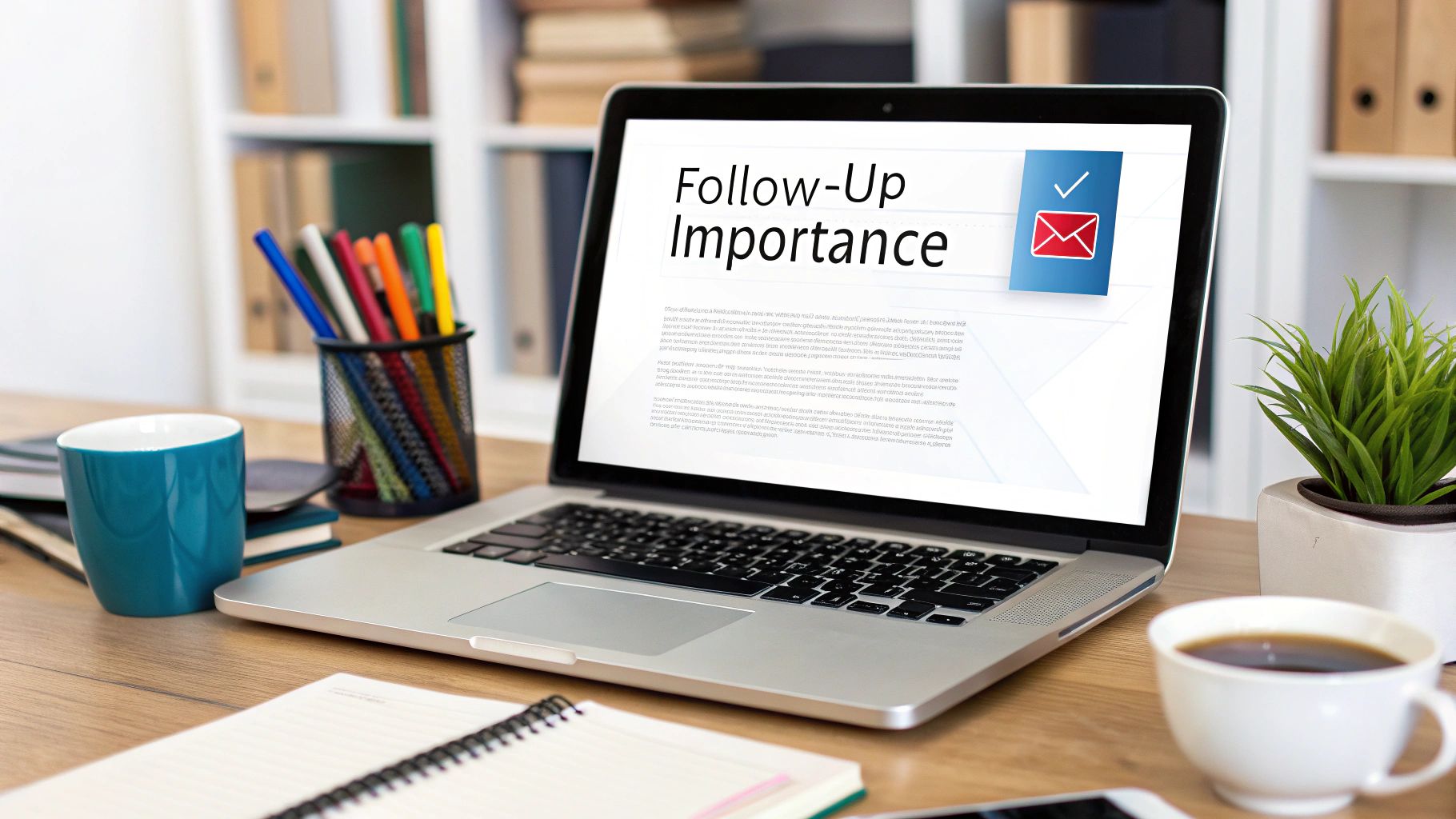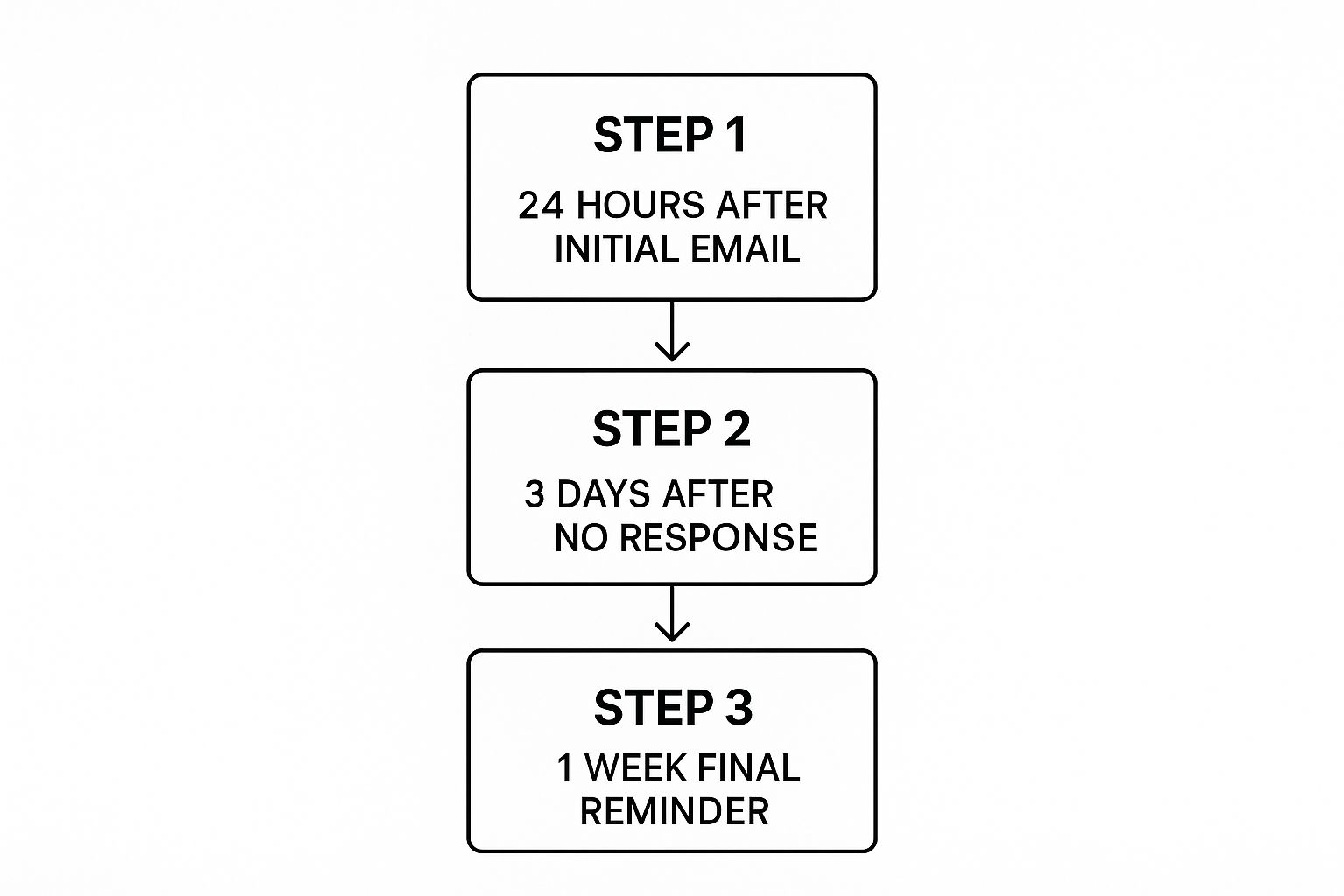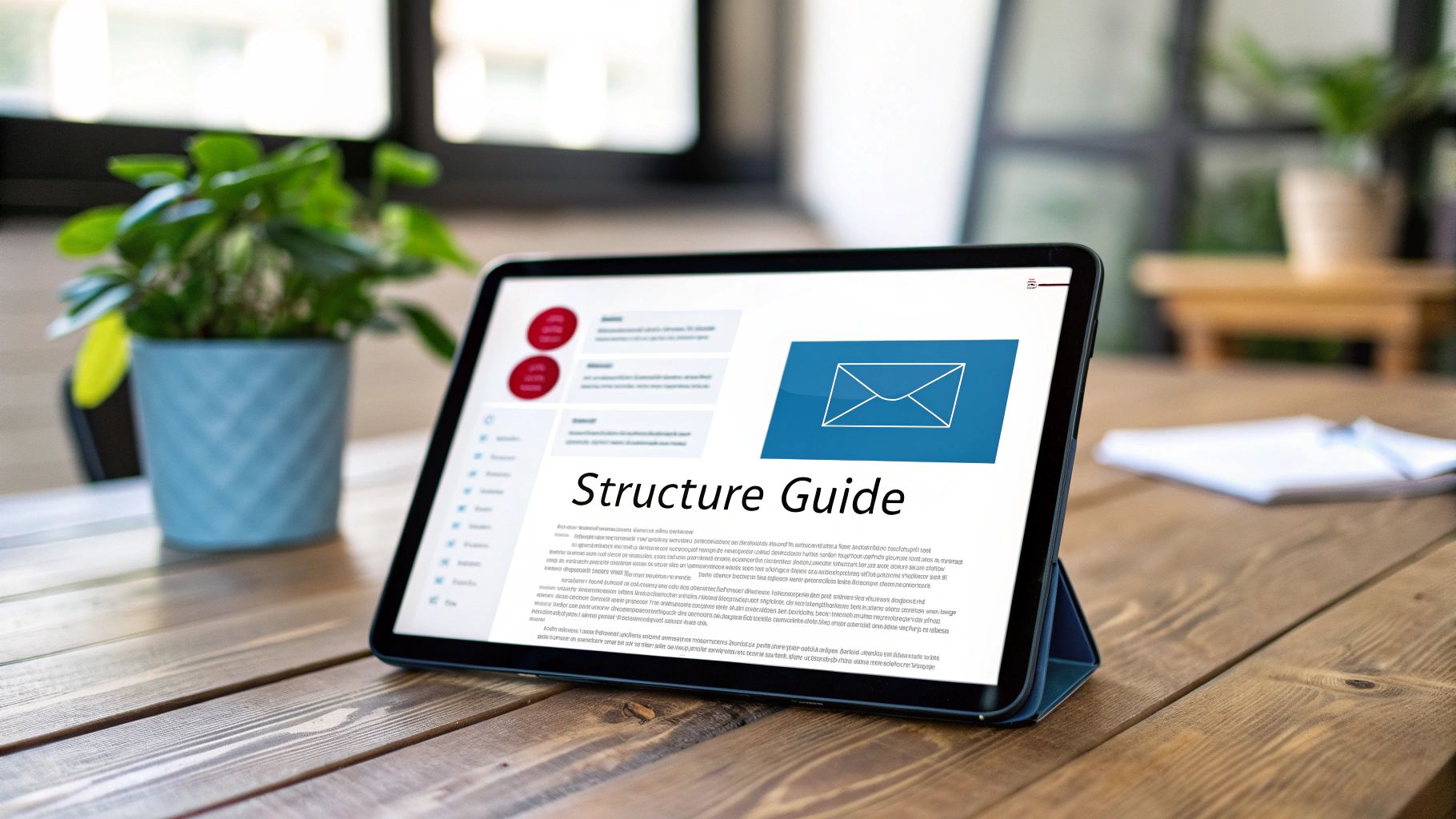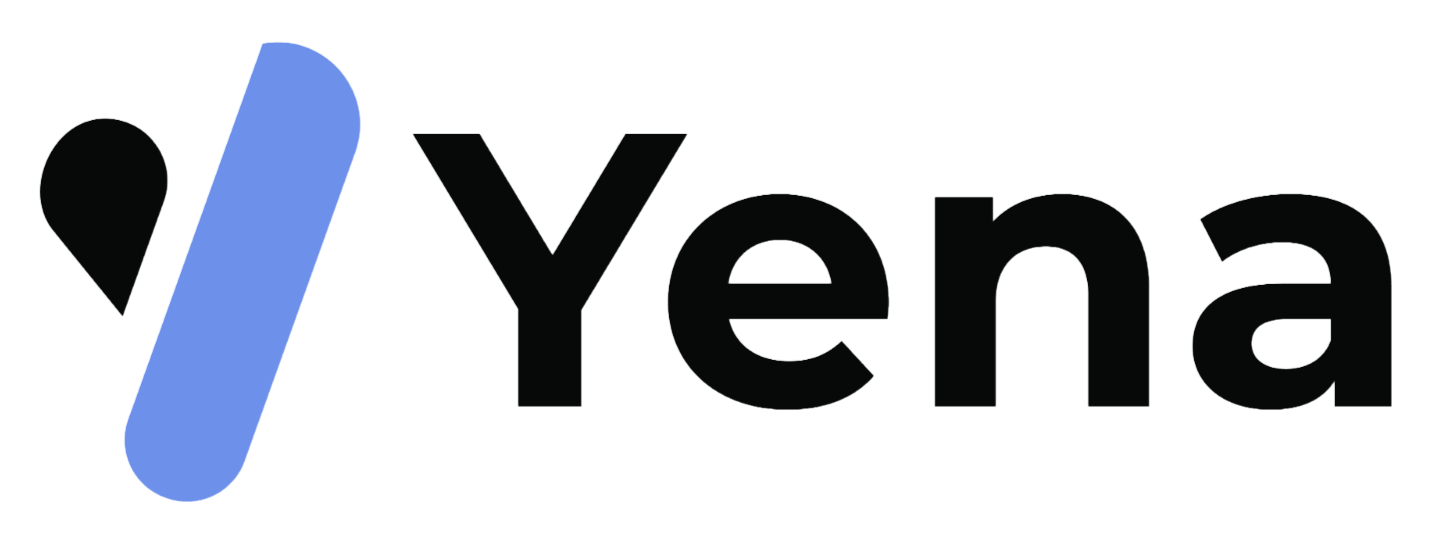Follow-Up Email Application Tips to Land Your Dream Job
- Janis Kolomenskis
- Jun 9
- 12 min read
Why Your Follow-Up Email Application Creates Real Opportunities

Let me tell you something: most job applicants either don't follow up after applying, or they send out those bland, cookie-cutter templates. This is where you come in. A genuine follow-up email can be your secret weapon. Seriously, I've heard recruiters talk about candidates who snagged offers purely because of their authentic follow-ups.
Think about it: hiring managers are drowning in applications. Your follow-up isn't just a nudge; it’s a chance to re-emphasize your interest, highlight your skills, and even add something new to your application. It shows you're truly interested. It separates you from those who didn't bother to show that level of commitment.
This brings us to the psychology of hiring. A follow-up can bump you from a "maybe" to a "must-hire." It shows initiative and professionalism – valuable traits in any employee. It also showcases your communication skills, essential in any workplace. Plus, a personalized follow-up lets you demonstrate your understanding of the role and the company, solidifying your fit.
Now, let’s talk about the "too pushy" myth. Done right, a follow-up is never pushy. It's about engagement. Most hiring teams appreciate candidates who are proactive and persistent. See it as continuing the conversation you started in the interview. This is particularly true in Latvia, where the digital infrastructure makes email communication a breeze. Their high-speed internet guarantees reliable and quick delivery, making follow-up emails incredibly effective. Discover more insights on Latvia's digital landscape. You might also find this helpful: Top Recruiting Best Practices To Attract Talent in 2025. So, use the power of the follow-up and watch your job prospects improve.
Mastering Follow-Up Email Application Timing Like Industry Insiders

This infographic gives you a simple three-step plan for timing your follow-up emails. 24 hours after your initial email, touch base. Then, if you haven't heard anything, reach out again three days later. Finally, send one last reminder after a week. See? Consistency is key, but don’t go overboard. Nobody likes being bombarded.
Beyond the Basics: Understanding Nuance in Follow-Up Timing
While that infographic is a helpful starting point, let's be real, things are rarely that straightforward. There’s no magic formula for perfect timing. Applying for a job at a small startup is a completely different ballgame than applying to a huge corporation. Their hiring processes and response times will naturally vary.
A smaller company might make quick decisions, so following up within a few days is perfectly reasonable. But a larger company might have a more involved, multi-stage process. In that case, patience is your best friend. Pay attention to any clues you picked up along the way. Did the hiring manager mention a timeline during your interview? Did the job description talk about a fast-paced environment? These little details can help you fine-tune your follow-up strategy.
Industry Insights and Seasonal Considerations
Industry norms matter too. Tech startups are famous for their rapid hiring cycles, while other industries might take a more measured approach. And don’t forget about seasonal factors! Following up around major holidays might mean your email gets lost in the shuffle. A well-timed follow-up during a quieter period, on the other hand, could really make you stand out. It's all about context.
Let's talk about why timing isn't just about dates on a calendar; it's about strategy. A thoughtful follow-up at the right moment can be game-changing. For example, a friend of mine was interviewing for a project manager role. A week after her interview, she followed up, referencing a specific project they’d discussed and offering a new perspective. This showed her genuine interest and proactive thinking – and she landed the job!
To help you navigate these nuances, I've put together a handy table:
Follow-Up Timeline By Interview Stage Strategic timing windows for different stages of the application process
This table provides a general guideline, but remember to adjust based on the specific circumstances of each job application. The key is to be proactive, but not pushy. Be strategic and use timing to your advantage.
The Power of Personalization
One last thing: personalization. Don’t just send generic follow-ups. Mention something specific you discussed in the interview, or relate your skills to the company's current projects. This shows you’ve done your homework and you're genuinely invested. A little effort goes a long way.
Crafting Subject Lines That Hiring Managers Actually Open

Your follow-up email subject line? It's the bouncer at the club. Decides if your message gets in, or stays out in the cold. Forget those tired, generic lines like "Thank you for your time." Let's talk about writing subject lines that grab attention and get your email opened.
The Psychology of a Click
Think about it. Hiring managers wade through hundreds of emails a day. What makes yours pop? Understanding a little email psychology goes a long way. Experts talk about trigger words – words that resonate in the hiring world. The trick is finding the balance between intriguing and professional. Ditch "Following up" and try something like "Checking In on the Marketing Manager Role." Specific, direct, and it reminds them exactly what you're after.
Even better? Reference something you talked about in the interview. Shows you were listening and are genuinely interested. Did you discuss their expansion into a new market? A subject line like "Following up on [Company Name]'s Expansion Plans" can be pure gold.
From Generic to Great: Real-World Examples
I’ve seen firsthand how the right subject line can make all the difference. Phrases like "Quick Question About the [Job Title] Role" or "Following Up on Our Conversation About [Specific Project]" tend to work well. They’re short, personalized, and signal a valuable conversation starter.
But a word of caution: while a little intrigue is good, avoid anything that feels like clickbait. Authenticity matters. Your subject line needs to accurately reflect your email’s content. It builds trust and sets the right expectations. Speaking of attracting talent, you might find this interesting: Writing a Job Description That Actually Attracts Top Talent.
Tailoring Your Approach
Not all interviews are created equal, right? A great conversation calls for a different approach than a so-so one. After a positive interview, let your enthusiasm shine through. "Excited About the [Job Title] Opportunity" can work wonders. If the vibe was less enthusiastic, a more neutral "Following Up on the [Job Title] Interview" might be a safer bet.
And here’s something to think about: following up is really a form of email marketing. And guess what? Email marketing has a killer ROI – an average return of $42 for every dollar spent as of 2025. Discover more insights on email marketing ROI. It just shows the power of a well-crafted email, especially when you’re nurturing a lead, just like in a job application. Your subject line? It's the first impression. Make it count.
Personalization That Goes Beyond Surface-Level Research
Real personalization isn't about casually mentioning their CEO's name or a recent press release. It's about showing genuine interest in them – their work, their passions, and what motivates them. Think of it less like filling out a template and more like building an actual connection.
Digging Deeper: Research That Matters
Forget generic compliments. They’re forgettable. Instead, focus on uncovering those details that truly resonate. Look beyond their company website. Explore their LinkedIn profiles, dive into industry forums, and even check out their personal blogs (if they have them). What are they passionate about? What projects are they currently involved in? These little nuggets can transform your follow-up from bland and generic to something that genuinely stands out.
For example, imagine you're applying for a marketing role at a tech startup. Instead of saying something generic like, "I'm impressed by your innovative products," dig a little deeper. Maybe a marketing manager recently spoke at a conference about a specific campaign. Mentioning that you found their presentation insightful shows you’re actually paying attention. It demonstrates genuine interest in their specific work. This kind of thoughtful research is especially important in a competitive digital marketing landscape. The fact that Latvia has 1.75 million internet users (as of early 2025) represents a substantial audience, and personalized email campaigns generate six times higher transaction rates than non-personalized emails. That speaks volumes! Check out more insights on Latvia's digital marketing scene here.
Weaving Your Experience into Their Narrative
Remember those specific conversation points from your interview? Use them! Referencing a particular challenge the company faces and explaining how your skills can directly address it shows you're not just interested in a job, but this job, specifically. It demonstrates a proactive mindset and a real understanding of their needs.
Continuing the Conversation, Not Just Repeating It
Your follow-up shouldn’t just rehash your resume. It should build upon the conversation you started in the interview. Did you discuss a particular industry trend? Share a recent article that adds to that discussion. Did they mention an upcoming project? Offer a fresh perspective based on your past experience. It’s these small gestures that make a big difference.
Showing You Understand Their Business
Go beyond the job description. Research the company's competitors, their market position, and their overall business strategy. Showing you understand the bigger picture demonstrates your commitment to their success, not just your own. This kind of personalized insight sets you apart and makes you a more compelling candidate. Remember, it’s not about stalking; it’s about strategic research. It's about showing you're genuinely invested in their mission and vision.
To help you personalize your follow-ups even further, I've put together this table outlining some powerful strategies:
Personalization Elements That Actually Work
Comparison of personalization strategies and their real-world effectiveness
The table highlights how powerful referencing shared connections and mentioning specific projects can be. Generic compliments have very little impact, so steer clear of those. Focusing on the high-impact strategies will make your follow-up emails truly stand out.
Templates That Sound Human, Not Like Email Marketing Bots

This Indeed screenshot shows a sample follow-up email template. See how it thanks the interviewer, reiterates interest, highlights skills, and has a call to action? These elements create a professional yet personal message. The key takeaway? Even with a template, personalization makes a strong impression.
Finding the Sweet Spot Between Structure and Authenticity
The best follow-up email templates are like your favorite jeans: comfortable, reliable, but with room to express your individual style. They offer structure without sacrificing authenticity. But finding that balance can be tricky.
So many people treat templates like a mad-libs exercise, just filling in the blanks. Instead, think of them as flexible frameworks you can adapt. Following up after an interview for a creative role at a Riga design agency? Totally different vibe than a finance position at a corporation. Adjust your language and focus accordingly.
Deconstructing Effective Follow-Up Frameworks
Successful job seekers know the power of a solid structure. Here's what makes a follow-up email memorable:
Start with gratitude: Thanking the interviewer for their time is just good manners.
Reiterate your interest: Remind them why you're excited about the opportunity.
Highlight relevant skills: Briefly touch on 1-2 key skills they need.
Reference specific conversation points: This shows you were paying attention.
End with a clear call to action: What do you want them to do next? Make it easy.
Adapting to Different Scenarios
Timing is everything, and so is context. A follow-up after a fantastic interview is different from one after a so-so conversation. Here’s how to adjust:
Enthusiastic follow-up (after a great interview): Let your excitement shine through! Mention a key takeaway and reiterate your strong interest.
Strategic check-in (after radio silence): Share a helpful resource or a new perspective related to something you discussed. It shows continued engagement without being pushy.
Recovery effort (after a lukewarm interaction): Briefly address any potential concerns and reiterate your qualifications. Focus on adding value, not dwelling on the less-than-ideal interview.
Making Templates Truly Yours
Generic examples just won't cut it. Personalize your templates by:
Referencing specific company projects or initiatives: It shows you've done your homework.
Mentioning industry trends relevant to their business: This demonstrates you understand their market.
Connecting your experience to their specific needs: Explain how your skills can solve their problems.
Remember, the goal is to connect. Personal touches and tailoring templates transform your follow-up from a formality into a networking opportunity. Every follow-up builds a relationship, no matter the outcome.
Strategic Follow-Up Sequences That Build Relationships
That fine line between persistent and pesky follow-up emails? It's all about strategy. Think of it like gardening: regular watering helps things grow, but too much drowns them. Let's talk about how to nurture relationships with recruiters, not annoy them.
Gauging Responsiveness and Adapting Your Approach
Every company operates at its own speed. A small startup in Riga might get back to you quickly, while a massive corporation might take a while. Pay attention to the clues. Did the recruiter give you a timeline? What’s the company culture like? These things can tell you a lot.
For example, a friend of mine was interviewing at a fast-paced tech company. She followed up within 48 hours because she knew they valued speed. It showed she could keep up! At a company with a more traditional feel, she waited a week.
And remember, things change. Projects get delayed, priorities shift. Be flexible. If the initial timeline passes, don't freak out. A short, helpful follow-up shows you’re still interested without being pushy. Maybe share a relevant industry article or a new thought about something you discussed. It shows you’re engaged, not anxious.
Adding Value, Not Just Repeating Interest
Every follow-up should bring something new to the table. Don’t just say you’re still excited about the job. Offer something useful! Let’s say you talked about a market challenge during your interview. Follow up with some insights from a recent report, connecting your skills to their needs. This shows you’re genuinely interested in their business, not just any job. You might also be interested in: Employee Referral Programs That Actually Drive Results.
This approach changes follow-ups from a chore to a chance to build relationships. Even if this particular role doesn't work out, you've made a connection. Think long-term. It’s about building a professional network, especially in Latvia.
Recognizing When to Redirect Your Energy
Sometimes, you won’t hear back, no matter what you do. And that’s okay. Know when to move on. Two to three well-timed follow-ups is usually enough. After that, respect their silence. Persistence is good, but chasing a non-responsive recruiter isn’t a good use of your time. Focus your energy on other opportunities.
Even a “no” can be useful, though! A polite final follow-up saying you're still interested in the company, even if this specific role wasn’t the right fit, can leave a positive impression. You never know what might open up in the future. Turn follow-ups into genuine relationship-building tools. It's a smart move for long-term career growth, particularly in Latvia where professional networks are often key.
Your Follow-Up Email Application Success Blueprint
So, you’ve sent off your applications, poured your heart into that cover letter, and nailed the interviews. Now what? This is where your follow-up game really comes into its own. It's time to turn all that effort into a system that actually works in the cutthroat job market.
Organizing Your follow-up email application
Think of following up like a personal marketing campaign. You need a system—a spreadsheet, a Trello board, whatever keeps you sane. Track every application: the date you applied, who you talked to, and when you followed up. This is crucial, especially when juggling multiple applications.
Imagine applying for five different roles. Keeping track of every interaction—dates, times, what you said—prevents you from accidentally sending the wrong email to the wrong person. Trust me, it’s a simple step that saves you from some major face-palms.
Measuring What Works and What Doesn't
Like any good marketing campaign, you need to analyze what's happening. Are people even opening your emails? Are those follow-up email applications turning into conversations? If not, switch things up. Try a different subject line, personalize your message a bit more.
This constant tweaking is essential. What works at one company might totally bomb at another. By tracking your results, you figure out what clicks with different hiring managers and adjust your strategy accordingly.
Managing Expectations and Maintaining Motivation
Job hunting is tough. It’s a rollercoaster. Be realistic. Not every follow-up will result in an offer. And that's okay. Every follow-up, regardless of the outcome, hones your communication and networking skills.
Even if a specific opportunity doesn't work out, you've still made a connection. A polite follow-up thanking the interviewer for their time, even if the answer is no, leaves a positive impression. You never know when another opportunity might pop up at that same company or within their network.
Turning Follow-Up Skills into Long-Term Advantages
These follow-up skills aren’t just for landing a job; they're for your entire career. They build relationships, show professionalism, and prove you're willing to put in the effort. These are valuable assets, period.
Think networking events, conferences, or even connecting with someone you admire on LinkedIn. A well-crafted follow-up can open doors to mentorship, collaborations, or even future job prospects. These skills will keep serving you long after this job search is over.
Ready to supercharge your hiring process and transform your candidate experience? Discover how Yena can help you hire smarter, faster, and with confidence.

Comments